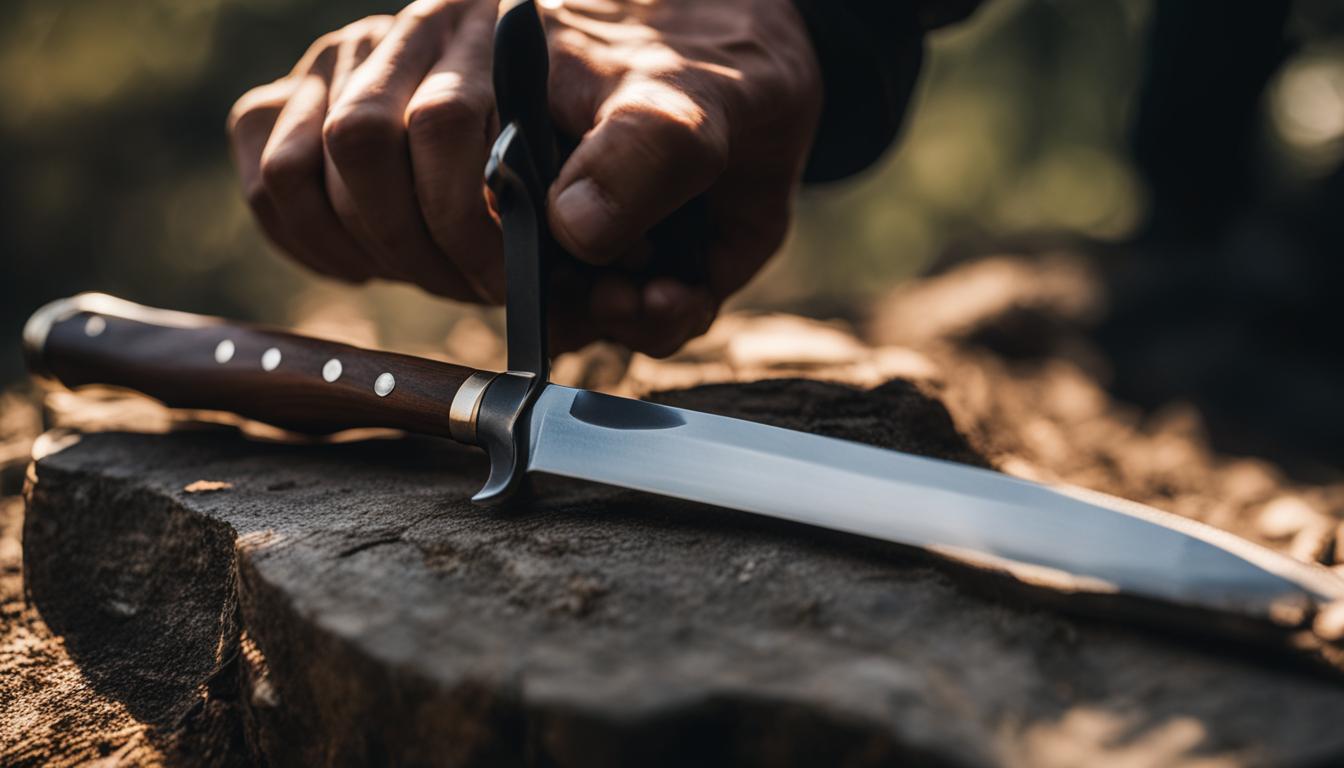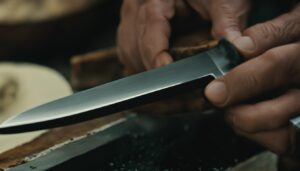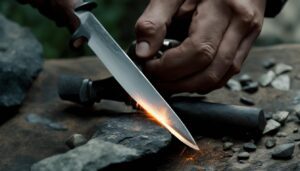Having a razor sharp knife can be the difference between effortless cutting and potential accidents. Japanese knives are known for their sharpness, which depends on the sharpening angle. The correct angle for Japanese knives is 10-15 degrees on one side for single bevel knives and 20-30 degrees in total for double bevel knives. Western blades have larger angles and thicker edges compared to Japanese knives. In this article, I will cover how to sharpen Japanese knives at the correct angle and maintain a consistent edge.
Key Takeaways:
- Japanese knives require a specific sharpening angle of 10-15 degrees for single bevel knives and 20-30 degrees for double bevel knives.
- Using a sharpening guide or visual aid can help maintain a consistent angle during the sharpening process.
- A whetstone is the best tool for sharpening Japanese knives, with grit grades ranging from #200 to #3000.
- Japanese knives are made from various steel types, each offering different properties and characteristics.
- Mastering Japanese knife sharpening techniques takes practice and precision, but will result in a sharp and long-lasting edge for your hunting knife.
Correct Japanese Knife Sharpening Angle
When it comes to sharpening your Japanese hunting knife, achieving the correct sharpening angle is crucial. Most Japanese knives have a double bevel, which means both sides need to be sharpened in order to maintain a sharp edge. The recommended sharpening angle for a standard Japanese chef’s knife, which is the most common type, is between 30-40 degrees on both sides combined.
Single bevel knives, on the other hand, have a flat side and only require sharpening on the beveled side. It’s important to note that the specific angle may vary depending on the type and brand of your knife. To determine the exact angle for your knife, it’s best to refer to the product manual or search for online information provided by the manufacturer.
Once you have determined the correct sharpening angle for your Japanese knife, you can proceed with sharpening and maintaining a consistent edge. Sharpening guides or visual aids can help you maintain the desired angle throughout the sharpening process, ensuring optimal results.
How to Sharpen a Japanese Knife at the Correct Angle
Sharpening a Japanese knife requires skill and precision. To achieve the correct angle, it is recommended to use a sharpening guide or visual aid to maintain consistency throughout the sharpening process. By doing so, you can ensure that your knife will retain its sharpness for longer periods.
One method to create a 15-degree angle is by using coins. Simply stack coins to the desired height and place the blade against them, ensuring that the angle is maintained as you sharpen. Another way is to measure and replicate the original angle of the blade using a protractor or angle measuring tool. This technique allows you to sharpen the knife at the exact angle it was initially designed for.
When it comes to sharpening Japanese knives, using a whetstone is highly recommended. Whetstones come in different grit grades, ranging from #200 to #3000. The choice of grit depends on the current sharpness of the knife. If the blade is dull or has significant nicks, start with a lower grit. Conversely, if the blade is already relatively sharp, you can begin with a higher grit to refine the edge further.
Remember to wet the whetstone before use to prevent metal shavings from clogging the surface. This will ensure a smooth and effective sharpening process. Slowly run the knife along the whetstone, maintaining the desired angle and applying even pressure. Repeat this process on both sides of the blade until you achieve the desired sharpness.
Table: Recommended Grit Grades for Japanese Knife Sharpening
| Grit Grade | Sharpness Level | Recommended Use |
|---|---|---|
| #200 – #600 | Coarse | For heavily damaged or dull blades |
| #800 – #1500 | Medium | For regular maintenance and sharpening |
| #2000 – #3000 | Fine | For refining and polishing the edge |
Using the correct angle and a whetstone, you can transform your Japanese knife into a razor-sharp tool. Practice and patience are key to mastering this art, but with time, you will be able to achieve perfect results. Remember to take your time, maintain consistency, and always prioritize safety when sharpening your hunting knife.
What to Use for Knife Sharpening
When it comes to sharpening your Japanese hunting knife, using the right tools is essential to achieve optimal results. While there are several methods available for sharpening knives, the most effective tool for Japanese knives is a whetstone. Whetstones, also known as sharpening stones, are specially designed to reform and refine the edge of the blade, ensuring a sharp and consistent edge.
Whetstones come in different grit grades, which determine the coarseness or fineness of the stone’s surface. The appropriate grit grade to use depends on the current sharpness of your knife. If your knife is in need of significant sharpening, starting with a lower grit grade, such as #200, can help remove any dullness or nicks on the blade. As you progress, you can move on to higher grit grades, such as #1000 or #3000, to refine the edge and achieve a razor-sharp finish.
To use a whetstone, it is important to wet the stone with water before starting the sharpening process. This helps prevent metal shavings from clogging the stone and ensures a smooth and accurate sharpening experience. Simply immerse the whetstone in water for about 10-15 minutes, or until the bubbles stop rising, before placing it on a stable surface.
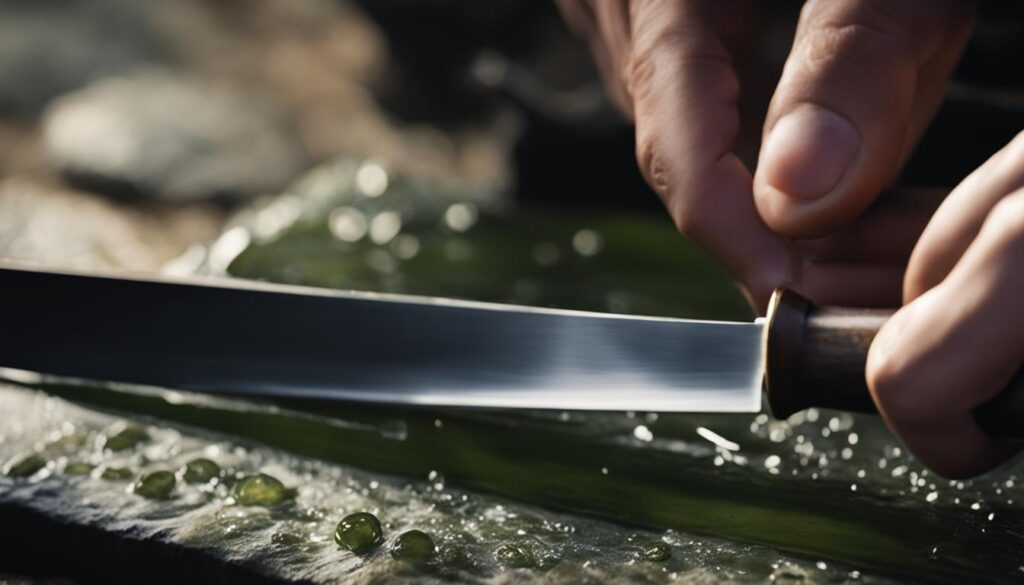
Once the whetstone is wet, you can begin sharpening your Japanese hunting knife. Hold the knife at the correct sharpening angle, which is typically between 10-30 degrees depending on the type of knife, and run the blade along the whetstone in a controlled and consistent motion. Repeat this process on both sides of the blade until you achieve the desired sharpness. Remember to maintain a steady pace and apply even pressure to ensure an even sharpening across the entire blade.
While there are other methods available, such as manual sharpeners, sharpening steels, and electric sharpeners, a whetstone remains the preferred choice for Japanese knives due to its versatility and ability to achieve a fine and precise edge. By using a whetstone and following the correct sharpening techniques, you can ensure that your Japanese hunting knife remains sharp and reliable for all your outdoor adventures.
Japanese Knife Steel Types
When it comes to Japanese knives, the choice of steel can greatly affect the knife’s performance and characteristics. Japanese knives are made from different types of steel, each with its own unique properties and qualities. Understanding the different steel types can help you make an informed decision when selecting a Japanese hunting knife and sharpening it to perfection.
A. Stainless Steel
Stainless steel is a popular choice for Japanese knives due to its excellent corrosion resistance and edge retention. Some common stainless steel types used in Japanese knives include VG-10, AUS-10, Ginsan/Silver No.3, and ZA-18. These steels offer a good balance of durability and sharpness, making them ideal for everyday use. Stainless steel knives are relatively low maintenance compared to high-carbon steel knives, as they are less prone to rust.
B. High-Carbon Steel
High-carbon steel knives are lauded for their superior sharpness and edge retention. However, they require more care and maintenance to prevent rust. Shirogami/White Steel and Aogami/Blue Steel are popular high-carbon steel choices for Japanese knives. These steels have a high carbon content, allowing them to achieve exceptional sharpness. High-carbon steel knives are favored by professional chefs and knife enthusiasts who value performance above all.
C. Yasugi Steel (Hagane)
Yasugi steel, also known as Hagane, is the traditional steel used in the production of Japanese knives. It offers a balance of durability, sharpness, and ease of maintenance. Yasugi steel is often combined with other types of steel to create layered or Damascus knives, which exhibit stunning visual patterns. Many renowned Japanese knife makers prefer to use Yasugi steel due to its trusted reputation and ability to produce high-quality blades.
| Steel Type | Properties | Maintenance |
|---|---|---|
| Stainless Steel | Good corrosion resistance, edge retention | Low maintenance, less prone to rust |
| High-Carbon Steel | Superior sharpness, edge retention | Requires more maintenance to prevent rust |
| Yasugi Steel (Hagane) | Balance of durability and sharpness | Relatively easy to maintain |
When choosing a Japanese hunting knife, consider your preferences and the intended use of the knife. Stainless steel knives provide a good balance of performance and convenience, while high-carbon steel knives offer unparalleled sharpness for those willing to put in the extra maintenance effort. Traditionalists may opt for knives made with Yasugi steel, appreciating its historical significance and versatility. Whichever steel type you choose, proper sharpening techniques and maintenance will ensure your Japanese knife remains a reliable tool for many years to come.
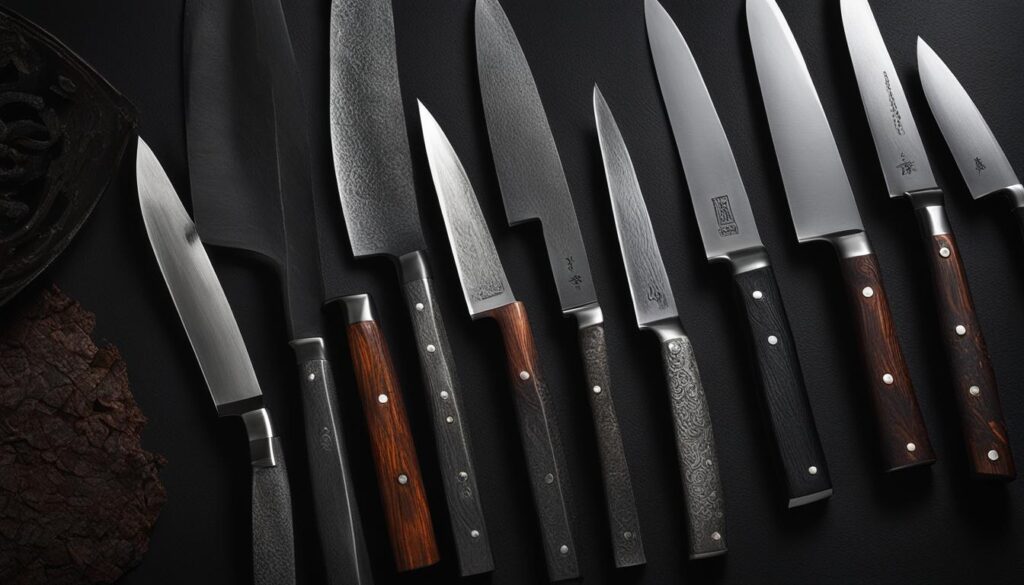

Conclusion
Mastering Japanese hunting knife sharpening techniques is essential for maintaining a razor-sharp edge on your knife. By understanding the correct sharpening angle, using the right tools, and selecting the appropriate steel type, you can elevate your sharpening skills and ensure long-lasting sharpness.
The first step to mastering Japanese knife sharpening is to determine the correct sharpening angle for your specific knife. Whether it’s a double bevel knife or a single bevel knife, knowing the exact angle will help you achieve optimal sharpness. Utilize a sharpening guide or visual aid to maintain a consistent angle throughout the sharpening process.
Next, invest in a high-quality whetstone for the best sharpening results. Whetstones offer a range of grit grades, allowing you to reshape and refine the edge of your knife. Wetting the whetstone is crucial to prevent metal shavings from clogging the stone and ensure a smooth sharpening experience.
Finally, consider the steel type of your Japanese knife. Stainless steel offers good edge retention and corrosion resistance, while high-carbon steel provides superior sharpness. Understanding the properties and characteristics of different steel types will help you choose the right one for your needs.
By following these Japanese hunting knife sharpening techniques and practicing regularly, you can master the art of sharpening and keep your knife in top-notch condition for all your outdoor adventures.
FAQ
What is the correct sharpening angle for a Japanese knife?
The correct sharpening angle for a standard Japanese chef’s knife is between 30-40 degrees on both sides combined.
Do Japanese knives have a single bevel or double bevel?
Most Japanese knives have a double bevel, meaning both sides need to be sharpened to maintain the fine edge. Single bevel knives have a flat side and only require sharpening on the beveled side.
How can I maintain a consistent sharpening angle when sharpening a Japanese knife?
It is recommended to find out the specific angle needed for your knife and use a sharpening guide or visual aid to maintain a consistent angle during the sharpening process. Coins can be used to create a 15-degree angle, or you can measure and replicate the original angle of the blade.
What is the best tool for sharpening a Japanese knife?
The best tool for sharpening a Japanese knife is a whetstone. Whetstones come in different grit grades and are used to reform and refine the edge of the blade.
What types of steel are used in Japanese knives?
Japanese knives are made from various steel types, including stainless steel and high-carbon steel. Stainless steel knives offer good edge retention and corrosion resistance, while high-carbon steel knives provide superior sharpness but require more maintenance due to their susceptibility to rust.
